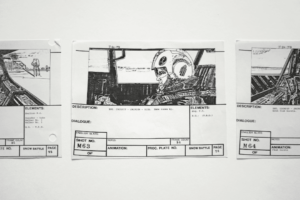A first assistant director, often written as 1st assistant director or a 1st AD for short, oversees a film, television, or commercial set during production. First assistant directors manage the schedule and coordinate cast and crew to ensure that shoots run smoothly. Their work considers the project’s budget, the time required, cast and crew availability, and location limitations. If actors run late or shooting locations become unavailable, first assistant directors must resolve these issues to keep filming on schedule. By handling the smaller details on the set, they allow directors to focus on their jobs.
What Does a First Assistant Director Do?
Common tasks for first assistant directors include:
- Helping break down the script into a storyboard before principal photography begins
- Developing a shooting schedule with the unit production manager, line producer, and director
- Contacting and hiring crew members
- Renting or purchasing filming equipment and props
- Preparing “day out of days” schedules and daily call sheets
- Discussing potential logistic challenges with the second assistant director
- Directing background action as instructed by the director
- Supervising lower-ranked assistant directors and production runners
- Supervising cast and crew on set for projects without second assistant directors
- Instructing and answering questions from key crew heads
- Monitoring sets for health and safety concerns and disciplining cast or crew when necessary
- Ensuring cast and crew take regular breaks according to union guidelines
- Tracking daily progress against production schedule
- Reviewing shot lists and preparing call sheets at the end of each day for the next shoot
- Completing Screen Actors Guild reports and production reports
In some cases, first assistant directors also perform the work of production unit managers. These duties may include securing contracts and releases from the cast.
Education and Training
Few courses provide specific training for this position, but many first assistant directors attend film school. Their classes give them a broad base of knowledge about their industry. This information complements the practical experience they get working on set. Learning on the job through production roles provides excellent training for aspiring first assistant directors.
Employment and Advancement for First Assistant Directors
First assistant directors often start their careers as production assistants. Working as a camera assistant or camera operator is another alternative. They then progress through the ranks, becoming second-second assistant directors, then second assistant directors, before finally becoming first assistant directors. Advancement comes with practical experience and building strong, trusting relationships on set.
Working as a first assistant director is the pinnacle for many people in the film industry. Others decide to further advance their careers and become producers or directors.
What Skills Do You Need to Work as a First Assistant Director?
First assistant directors rely on a range of technical and soft skills to succeed in their roles. These skills include:
- Comprehensive understanding of how film sets operate and the roles of all crew members
- Extensive knowledge of filming processes, including camera operation, sound recording, and lighting
- Thorough understanding of production business and logistics
- Organization, time management, and multitasking skills
- Attention to detail for effective scheduling
- Efficient problem-solving skills for resolving challenges on set
- Ability to negotiate to secure locations and equipment at the best price
- Conflict resolution skills for resolving interpersonal problems between cast and crew members
- Verbal and written communication skills, including active listening and diplomacy
- Leadership skills, including the ability to motivate cast and crew and command their attention
- Forward-thinking to anticipate problems and find solutions ahead of time
- First aid to give medical attention on set if required
Common Personality Traits of First Assistant Directors
To be a successful first assistant director, it’s important to have certain personality traits to ensure that you can work well with cast and crew members. Most of the best first assistant directors have the following characteristics in common:
- Perfectionism to strive for excellence on set
- Confidence for directing others
- Logic to resolve problems
- Calmness and patience, even during crises
- Approachability to encourage questions
- Collaborative to thrive when working with others
- Flexibility to adapt to changing conditions on set
- Commitment and passion for work to handle the demanding lifestyle
Lifestyle
First assistant directors work in a high-pressure environment that is constantly changing. It’s common for shoots to last up to 12 to 16 hours, so these professionals often work long days. These hours may be late at night or very early in the morning, depending on the shoot’s requirements. First assistant directors then take their work home with them, writing reports, reviewing shot lists, and creating new daily call sheets to prepare for the next day.
Since these professionals often work as freelance contractors, they may have a substantial amount of downtime between projects. These quiet periods can help first assistant directors find the work-life balance they need. They also use these periods to find their next project.
How Much Does a First Assistant Director Make?
As first assistant directors help film, television, and commercial shoots stay on budget, they are often compensated well for their work. The average salary for a first assistant director employed by a studio is $192,000. Small indie and low-budget films usually pay between $350 and $600 a day.
Rates vary from project to project, and freelance first assistant directors must negotiate a salary for themselves. They usually consider each project’s salary and the possible networking opportunities before accepting or declining work. They may accept lower salaries to work with creative people they admire.
Unions, Groups, and Associations
There are several organizations that can help first assistant directors throughout their careers. All first assistant directors should join the Directors Guild of America (DGA). Membership is not compulsory, but it is essential for working on productions that are signatories of the DGA and operating under its collective bargaining agreement. That includes projects from major production companies and studios.
Additionally, the IATSE Labor Union shares resources and campaigns for fairer wages that can help you as a first assistant director. Facebook also has several relevant groups you can join, including “I Need an Assistant Director!” and “Production Resource Group.”
Other excellent organizations include:
- Film Independent
- Independent Film Project (IFP)
Tips for Getting Started as a First Assistant Director
Securing work as a first assistant director can be challenging. Use these tips to help you get started:
- Network with other first assistant directors.
- Spend time on film sets to familiarize yourself with their operation.
- Network with a range of crew members to learn more about their roles.
- Develop your understanding of call sheets and shot lists.
How to Become a Better First Assistant Director
Once you become a first assistant director, you should think of ways you can improve your performance. Becoming a better first assistant director will help you secure more regular work and higher rates. The following tips can help you improve in your position:
- Introduce a five-minute stand-up meeting at the start of each day of production so that everyone has clear expectations and time to ask questions.
- Make time to walk through scenes and anticipate any challenges.
- Communicate with departments between scene setups.
- Improve your communication skills by presenting only relevant information in an even tone.
- Own any mistakes on set and work on resolutions, even if they are not your own.
- Involve only relevant cast and crew in problem resolution.
- Be generous with your time estimates to allow time for problem-solving.
- Learn the names of all cast and crew members to build rapport.
- Thank the cast and crew for their work.
- Campaign for better food and drinks on set to boost energy and morale.
- Involve cast in decisions to keep them engaged.
- Focus on what matters.
Working as a first assistant director is the ideal role for organized, confident people committed to the film industry. If you’re interested in learning more about this role, apply to the Nashville Film Institute to gain professional qualifications as a filmmaker.













